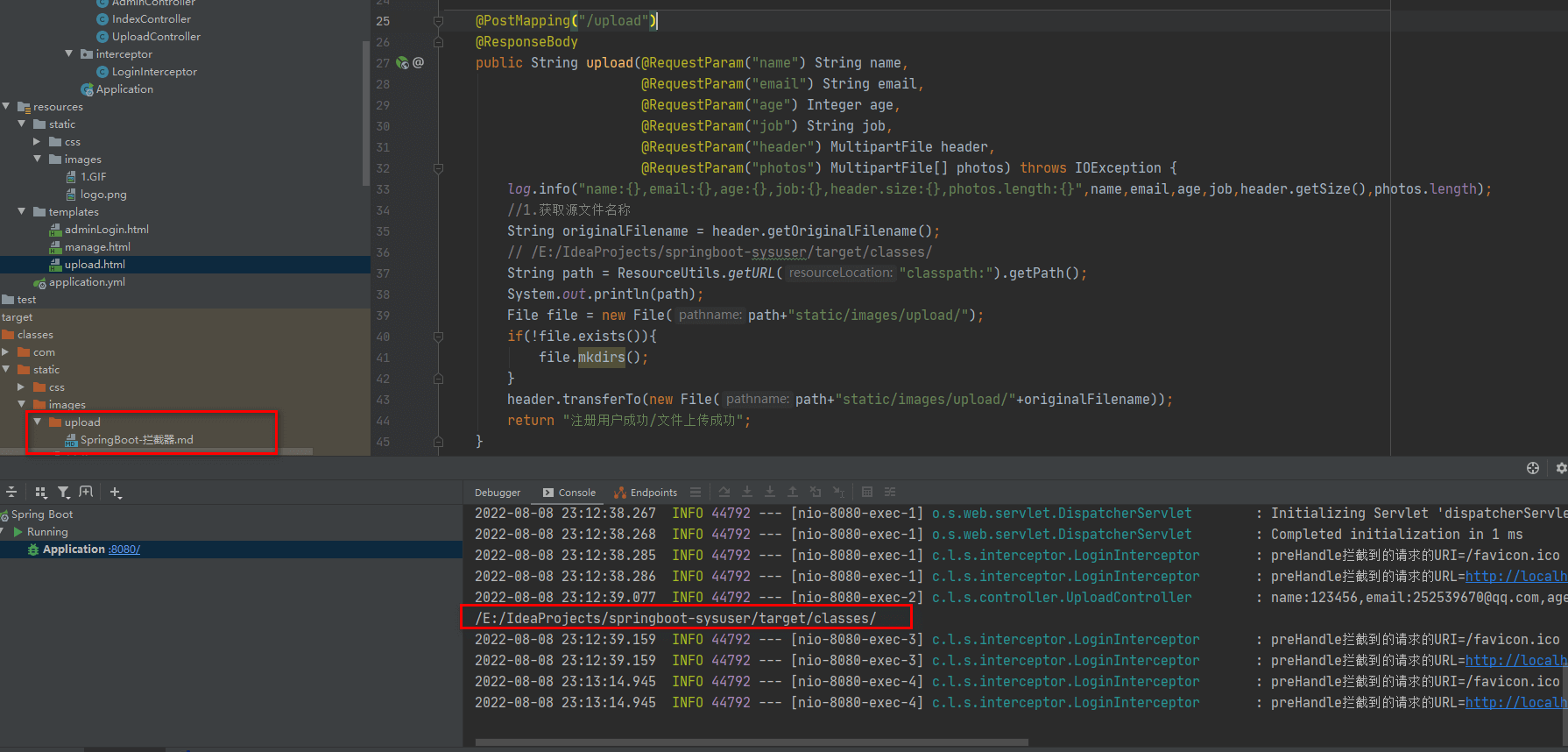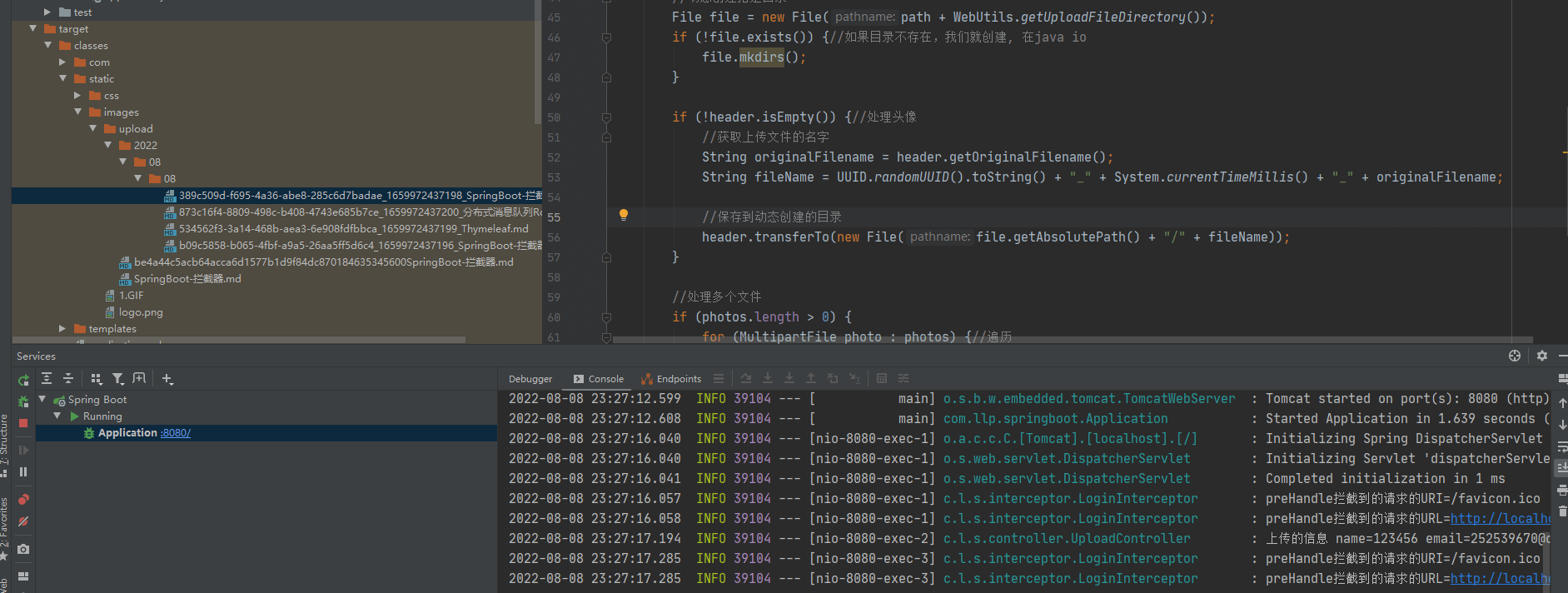How to implement SpringBoot file upload function
1. Application example
Requirements: Demonstrate Spring-Boot to register users through forms and support uploading pictures
2. Code implementation
Code implementation-file upload
Please create templates/upload.html, ensure that only one avatar can be selected, and pets can upload multiple pictures
<!DOCTYPE html>
<html lang="en" xmlns:th="http://www.thymeleaf.org">
<head>
<meta charset="UTF-8">
<title>upload</title>
</head>
<body bgcolor="#CED3FE">
<img src="/static/imghw/default1.png" data-src="images/1.GIF" class="lazy" / alt="How to implement SpringBoot file upload function" >
<hr/>
<div >
<h2 id="注册用户">注册用户~</h2>
<form action="#" th:action="@{/upload}" method="post" enctype="multipart/form-data">
用户名:<input type="text" name="name"/><br/><br/>
电 邮:<input type="text" name="email"/><br/><br/>
年 龄:<input type="text" name="age"/><br/><br/>
职 位:<input type="text" name="job"/><br/><br/>
头 像:<input type="file" name="header"><br/><br/>
宠 物:<input type="file" name="photos" multiple><br/><br/>
<input type="submit" value="注册"/>
<input type="reset" value="重新填写"/>
</form>
</div>
<hr/>
</body>
</html>2. Create src\main\java\com\llp\springboot\controller \UploadController.java
@Slf4j
@Controller
public class UploadController {
//处理转发到用户注册-可以完成文件上传页面
@GetMapping("/upload.html")
public String uploadPage() {
return "upload";// 视图解析,转发到templates/upload.html
}
@PostMapping("/upload")
@ResponseBody
public String upload(@RequestParam("name") String name,
@RequestParam("email") String email,
@RequestParam("age") Integer age,
@RequestParam("job") String job,
@RequestParam("header") MultipartFile header,
@RequestParam("photos") MultipartFile[] photos) throws IOException {
log.info("name:{},email:{},age:{},job:{},header.size:{},photos.length:{}",name,email,age,job,header.getSize(),photos.length);
//1.获取源文件名称
String originalFilename = header.getOriginalFilename();
// /E:/IdeaProjects/springboot-sysuser/target/classes/
String path = ResourceUtils.getURL("classpath:").getPath();
System.out.println(path);
File file = new File(path+"static/images/upload/");
if(!file.exists()){
file.mkdirs();
}
header.transferTo(new File(path+"static/images/upload/"+originalFilename));
return "注册用户成功/文件上传成功";
}
}

@PostMapping("/upload")
@ResponseBody
public String upload(@RequestParam("name") String name,
@RequestParam("email") String email,
@RequestParam("age") Integer age,
@RequestParam("job") String job,
@RequestParam("header") MultipartFile header,
@RequestParam("photos") MultipartFile[] photos) throws IOException {
log.info("name:{},email:{},age:{},job:{},header.size:{},photos.length:{}",name,email,age,job,header.getSize(),photos.length);
//1.获取源文件名称
String originalFilename = header.getOriginalFilename();
originalFilename = UUID.randomUUID().toString().replaceAll("-","")+System.nanoTime()+originalFilename;
//2.获取文件上传的路径
// /E:/IdeaProjects/springboot-sysuser/target/classes/
String path = ResourceUtils.getURL("classpath:").getPath();
System.out.println(path);
//3.动态的创建文件上传目录
File file = new File(path+"static/images/upload/");
if(!file.exists()){
file.mkdirs();
}
//4.将文件传输到目标目录
header.transferTo(new File(path+"static/images/upload/"+originalFilename));
return "注册用户成功/文件上传成功";
}originalFilename = UUID.randomUUID().toString().replaceAll("-","") System.nanoTime() originalFilename;, the implementation idea is to re-upload the file Specify a unique file name

public class WebUtils {
//定义一个文件上传的路径
public static String UPLOAD_FILE_DIRECTORY = "static/images/upload/";
//编写方法,生成一个目录-根据当前日期 年/月/日
public static String getUploadFileDirectory() {
return UPLOAD_FILE_DIRECTORY + new SimpleDateFormat("yyyy/MM/dd").format(new Date());
}
}@PostMapping("/upload")
@ResponseBody
public String upload(@RequestParam("name") String name,
@RequestParam("email") String email,
@RequestParam("age") Integer age,
@RequestParam("job") String job,
@RequestParam("header") MultipartFile header,
@RequestParam("photos") MultipartFile[] photos) throws IOException {
//输出获取到的信息
log.info("上传的信息 name={} email={} age={} job={} header={} photos={} ",
name, email, age, job, header.getSize(), photos.length);
//得到类路径(运行的时候)
String path = ResourceUtils.getURL("classpath:").getPath();
//log.info("path={}", path);
//动态创建指定目录
File file = new File(path + WebUtils.getUploadFileDirectory());
if (!file.exists()) {//如果目录不存在,我们就创建, 在java io
file.mkdirs();
}
if (!header.isEmpty()) {//处理头像
//获取上传文件的名字
String originalFilename = header.getOriginalFilename();
String fileName = UUID.randomUUID().toString() + "_" + System.currentTimeMillis() + "_" + originalFilename;
//保存到动态创建的目录
header.transferTo(new File(file.getAbsolutePath() + "/" + fileName));
}
//处理多个文件
if (photos.length > 0) {
for (MultipartFile photo : photos) {//遍历
if (!photo.isEmpty()) {
String originalFilename = photo.getOriginalFilename();
String fileName = UUID.randomUUID().toString() + "_" + System.currentTimeMillis() + "_" + originalFilename;
//保存到动态创建的目录
photo.transferTo(new File(file.getAbsolutePath() + "/" + fileName));
}
}
}
return "注册用户成功/文件上传成功";
}
The above is the detailed content of How to implement SpringBoot file upload function. For more information, please follow other related articles on the PHP Chinese website!

Hot AI Tools

Undresser.AI Undress
AI-powered app for creating realistic nude photos

AI Clothes Remover
Online AI tool for removing clothes from photos.

Undress AI Tool
Undress images for free

Clothoff.io
AI clothes remover

Video Face Swap
Swap faces in any video effortlessly with our completely free AI face swap tool!

Hot Article

Hot Tools

Notepad++7.3.1
Easy-to-use and free code editor

SublimeText3 Chinese version
Chinese version, very easy to use

Zend Studio 13.0.1
Powerful PHP integrated development environment

Dreamweaver CS6
Visual web development tools

SublimeText3 Mac version
God-level code editing software (SublimeText3)

Hot Topics
 1666
1666
 14
14
 1426
1426
 52
52
 1328
1328
 25
25
 1273
1273
 29
29
 1253
1253
 24
24
 How Springboot integrates Jasypt to implement configuration file encryption
Jun 01, 2023 am 08:55 AM
How Springboot integrates Jasypt to implement configuration file encryption
Jun 01, 2023 am 08:55 AM
Introduction to Jasypt Jasypt is a java library that allows a developer to add basic encryption functionality to his/her project with minimal effort and does not require a deep understanding of how encryption works. High security for one-way and two-way encryption. , standards-based encryption technology. Encrypt passwords, text, numbers, binaries... Suitable for integration into Spring-based applications, open API, for use with any JCE provider... Add the following dependency: com.github.ulisesbocchiojasypt-spring-boot-starter2. 1.1Jasypt benefits protect our system security. Even if the code is leaked, the data source can be guaranteed.
 How to use Redis to implement distributed locks in SpringBoot
Jun 03, 2023 am 08:16 AM
How to use Redis to implement distributed locks in SpringBoot
Jun 03, 2023 am 08:16 AM
1. Redis implements distributed lock principle and why distributed locks are needed. Before talking about distributed locks, it is necessary to explain why distributed locks are needed. The opposite of distributed locks is stand-alone locks. When we write multi-threaded programs, we avoid data problems caused by operating a shared variable at the same time. We usually use a lock to mutually exclude the shared variables to ensure the correctness of the shared variables. Its scope of use is in the same process. If there are multiple processes that need to operate a shared resource at the same time, how can they be mutually exclusive? Today's business applications are usually microservice architecture, which also means that one application will deploy multiple processes. If multiple processes need to modify the same row of records in MySQL, in order to avoid dirty data caused by out-of-order operations, distribution needs to be introduced at this time. The style is locked. Want to achieve points
 How SpringBoot integrates Redisson to implement delay queue
May 30, 2023 pm 02:40 PM
How SpringBoot integrates Redisson to implement delay queue
May 30, 2023 pm 02:40 PM
Usage scenario 1. The order was placed successfully but the payment was not made within 30 minutes. The payment timed out and the order was automatically canceled. 2. The order was signed and no evaluation was conducted for 7 days after signing. If the order times out and is not evaluated, the system defaults to a positive rating. 3. The order is placed successfully. If the merchant does not receive the order for 5 minutes, the order is cancelled. 4. The delivery times out, and push SMS reminder... For scenarios with long delays and low real-time performance, we can Use task scheduling to perform regular polling processing. For example: xxl-job Today we will pick
 How to solve the problem that springboot cannot access the file after reading it into a jar package
Jun 03, 2023 pm 04:38 PM
How to solve the problem that springboot cannot access the file after reading it into a jar package
Jun 03, 2023 pm 04:38 PM
Springboot reads the file, but cannot access the latest development after packaging it into a jar package. There is a situation where springboot cannot read the file after packaging it into a jar package. The reason is that after packaging, the virtual path of the file is invalid and can only be accessed through the stream. Read. The file is under resources publicvoidtest(){Listnames=newArrayList();InputStreamReaderread=null;try{ClassPathResourceresource=newClassPathResource("name.txt");Input
 How to implement Springboot+Mybatis-plus without using SQL statements to add multiple tables
Jun 02, 2023 am 11:07 AM
How to implement Springboot+Mybatis-plus without using SQL statements to add multiple tables
Jun 02, 2023 am 11:07 AM
When Springboot+Mybatis-plus does not use SQL statements to perform multi-table adding operations, the problems I encountered are decomposed by simulating thinking in the test environment: Create a BrandDTO object with parameters to simulate passing parameters to the background. We all know that it is extremely difficult to perform multi-table operations in Mybatis-plus. If you do not use tools such as Mybatis-plus-join, you can only configure the corresponding Mapper.xml file and configure The smelly and long ResultMap, and then write the corresponding sql statement. Although this method seems cumbersome, it is highly flexible and allows us to
 How SpringBoot customizes Redis to implement cache serialization
Jun 03, 2023 am 11:32 AM
How SpringBoot customizes Redis to implement cache serialization
Jun 03, 2023 am 11:32 AM
1. Customize RedisTemplate1.1, RedisAPI default serialization mechanism. The API-based Redis cache implementation uses the RedisTemplate template for data caching operations. Here, open the RedisTemplate class and view the source code information of the class. publicclassRedisTemplateextendsRedisAccessorimplementsRedisOperations, BeanClassLoaderAware{//Declare key, Various serialization methods of value, the initial value is empty @NullableprivateRedisSe
 Comparison and difference analysis between SpringBoot and SpringMVC
Dec 29, 2023 am 11:02 AM
Comparison and difference analysis between SpringBoot and SpringMVC
Dec 29, 2023 am 11:02 AM
SpringBoot and SpringMVC are both commonly used frameworks in Java development, but there are some obvious differences between them. This article will explore the features and uses of these two frameworks and compare their differences. First, let's learn about SpringBoot. SpringBoot was developed by the Pivotal team to simplify the creation and deployment of applications based on the Spring framework. It provides a fast, lightweight way to build stand-alone, executable
 How to get the value in application.yml in springboot
Jun 03, 2023 pm 06:43 PM
How to get the value in application.yml in springboot
Jun 03, 2023 pm 06:43 PM
In projects, some configuration information is often needed. This information may have different configurations in the test environment and the production environment, and may need to be modified later based on actual business conditions. We cannot hard-code these configurations in the code. It is best to write them in the configuration file. For example, you can write this information in the application.yml file. So, how to get or use this address in the code? There are 2 methods. Method 1: We can get the value corresponding to the key in the configuration file (application.yml) through the ${key} annotated with @Value. This method is suitable for situations where there are relatively few microservices. Method 2: In actual projects, When business is complicated, logic




